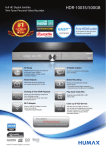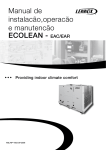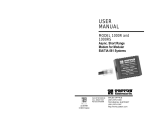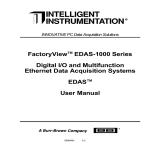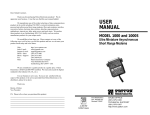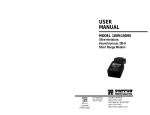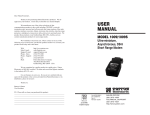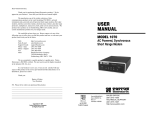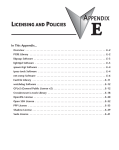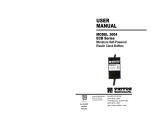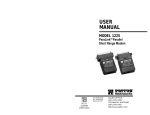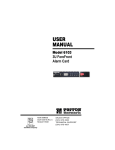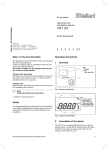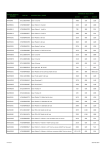Download USER MANUAL
Transcript
USER MANUAL MODEL 1003 and 1003S Asynchronous, 2-Wire, Carrier Sense Short Range Modem Part #07M1003-B Doc. #050021UB Revised 4/28/98 An ISO-9001 Certified Company SALES OFFICE (301) 975-1000 TECHNICAL SUPPORT (301) 975-1007 http://www.patton.com 1.0 WARRANTY INFORMATION 1.3 SERVICE Patton Electronics warrants all Model 1003 components to be free from defects, and will—at our option—repair or replace the product should it fail within one year from the first date of shipment. This warranty is limited to defects in workmanship or materials, and does not cover customer damage, abuse or unauthorized modification. If this product fails or does not perform as warranted, your sole recourse shall be repair or replacement as described above. Under no condition shall Patton Electronics be liable for any damages incurred by the use of this product. These damages include, but are not limited to, the following: lost profits, lost savings and incidental or consequential damages arising from the use of or inability to use this product. Patton Electronics specifically disclaims all other warranties, expressed or implied, and the installation or use of this product shall be deemed an acceptance of these terms by the user. 1.1 RADIO AND TV INTERFERENCE The Model 1003 generates and uses radio frequency energy, and if not installed and used properly—that is, in strict accordance with the manufacturer's instructions—may cause interference to radio and television reception. The Model 1003 has been tested and found to comply with the limits for a Class A computing device in accordance with the specifications in Subpart J of Part 15 of FCC rules, which are designed to provide reasonable protection from such interference in a commercial installation. However, there is no guarantee that interference will not occur in a particular installation. If the Model 1003 does cause interference to radio or television reception, which can be determined by disconnecting the RS-232 interface, the user is encouraged to try to correct the interference by one or more of the following measures: moving the computing equipment away from the receiver, re-orienting the receiving antenna and/or plugging the receiving equipment into a different AC outlet (such that the computing equipment and receiver are on different branches). All warranty and nonwarranty repairs must be returned freight prepaid and insured to Patton Electronics. All returns must have a Return Materials Authorization number on the outside of the shipping container. This number may be obtained from Patton Electronics Technical Service at telephone: (301) 975-1007, web address: http://www.patton.com; email: [email protected]. NOTE: Packages received without an RMA number will not be accepted. Patton Electronics’ technical staff is also available to answer any questions that might arise concerning the installation or use of your Model 1003. Technical Service hours: 8AM to 5PM EST, Monday through Friday. 1.2 CE NOTICE The CE symbol on your Patton Electronics equipment indicates that it is in compliance with the Electromagnetic Compatibility (EMC) directive and the Low Voltage Directive (LVD) of the Union European (EU). A Certificate of Compliance is available by contacting Patton Technical Support. 1 2 GENERAL INFORMATION Thank you for your purchase of this Patton Electronics product. This product has been thoroughly inspected and tested and is warranted for One Year parts and labor. If any questions or problems arise during installation or use of this product, please do not hesitate to contact Patton Electronics Technical Support at (301)-975-1007. FEATURES • "Carrier Sense" automatically detects presence of received signal on the line • Ideal for UNIX and similar environments where host needs to receive a carrier signal before sending a "log-on" screen to a terminal • Allows troubleshooting of a line: loss of carrier indicates problem at remote connection • Full Duplex operation over coax or a single twisted pair. • Data rates to 19,200 bps • Range to 1 mile. • No AC power required: draws necessary power from RS-232 signals. • External DCE/DTE switch CONFIGURATION Configuring the DTE/DCE Switch. Terminals (DTEs) want to "talk" to modems (DCEs), not to other terminals. This is because terminals and modems talk to each other on complementary pins. Terminals talk on pin 2, while modems talk on pin 3. Similarly, terminals listen on pin 3, while modems listen on pin 2. The DTE/DCE switch on the Model 1003 determines whether the Model 1003 "thinks" it's a modem (DCE) or a terminal (DTE). If you are connecting the Model 1003 to a terminal or PC, set the switch to DCE. If you are connecting the Model 1003 to a modem or multiplexer, set the switch to DTE. DCE/DTE Switch Terminal Block Surge Suppressors (1003S only) DESCRIPTION The Model 1003 is a Carrier Sense Short Range Modem that connects computers and terminals over a single coax or single twisted pair cable. The Model 1003 derives necessary power for operation from the data and control voltages on the RS-232 interface. The Model 1003 with "carrier sense" is ideal for UNIX and other environments in which the host requires a carrier detect signal on pin 8 before it sends a "log-on" screen to the terminal. The carrier sense feature works like this: The Model 1003 monitors its received line. When a signal is received from the line, pin 8 (CD) tells the host to send a "log-on" screen to the terminal. If the received signal is lost or interrupted, the carrier detect signal is held low to the host. The Model 1003's carrier sense feature makes it ideal for trouble shooting in nonUNIX applications as well. The Model 1003S is a surge protected version of the Model 1002 that uses the latest in bi-directional, clamping, transient suppressors to protect itself and connected equipment against harmful transient discharges. For surge handling capability, the Model 1003S is compliant with IEC 801.5 level 2, 1kV. 3 DCE DTE INSTALLATION General Instructions. The Model 1003 is intended for point-to-point communication over a single coax or one-pair cable. Two Model 1003's are needed for each communication link: one at each end of the cable. Please be sure that the cable you use has no equalizers, conditioners, or other equipment installed that could affect the signal passed between the two Model 1003s--they need dry, unconditioned metallic cable. 4 A. Connecting to the RS-232 Interface. The Model 1003 and 1003S are designed to plug directly into the DB-25 (RS-232) interface of a terminal or modem. Connection may also be made using a short RS-232 cable. Note: The connecting cable must have at least pins 2,3 and 7 wired STRAIGHT THROUGH. For best results, this cable should be as short as possible. C. Two-Wire Connection Using Coax. When using coax for twowire connection, the coax cable should be terminated with male BNC connectors. Simply twist these onto the female connectors on the Model 1003/1003S units and start computing! B. Two-Wire Connection Using RJ-11 and RJ-45 Jacks. When using the RJ-11 or RJ-45 modular jacks for two-wire connection, it is necessary to employ "straight through" cabling between the modems. Pin-outs are shown below: RJ-11 Wiring Modem #1 Modem#2 SIGNAL PIN# COLOR* COLOR* PIN# SIGNAL DATA GND 3 4 Green Red 3 4 Green Red DATA GND RJ-45 Wiring 1. Modem #1 Modem#2 SIGNAL PIN# COLOR* COLOR* PIN# SIGNAL DATA GND 4 5 Red Green 4 5 Red Green D. Two-Wire Connection Terminal Blocks and Strain Relief. Model 1003 and 1003S modems that are not equipped with coax connectors or modular jacks allow for two-wire connection via internal terminal blocks. An external strain relief collar--integrated into the plastic case--holds the cable securely in place so that it won't pull loose from the terminal block connections. Follow these step-by-step instructions to wire up the Model 1003/1003S using the terminal block/strain-relief assembly: Open the plastic case by gently inserting a screw driver between the DB-25 connector and the lip of the plastic case. There is no need to worry about breaking the plastic--just be careful not to bend the metal DB-25 connector. DATA GND * Standard Color Codes - Yours may be different 1 - Blue 2 - Orange 3 - Black 4 - Red 5 - Green 6 - Yellow 7 - Brown 8 - Slate 1 - Blue 2 - Yellow 3 - Green 4 - Red 5 - Black 6 - White AT&T Standard pins/colors 5 6 2. Strip the outer insulation from the twisted pair about one inch from the end. 3. Strip back the insulation on each of the two wires about .25", 4. 6. Insert the strain relief assembly with the wire going through it into the slot in the bottom half of the modem case and seat it into the recess in the case. (If the telephone wire is too thin to be held by the strain relief assembly, use tape to increase its diameter. If the wire is too large, it may be necessary to drill out the strain relief slightly. 6. BEND the top half of the case as necessary to place it over the strain relief assembly. Do not snap the case together yet. 7. Insert one captive screw through a saddle washer and then insert the captive screw with the washer on it, through the hole in the DB-25 end of the case. Snap that side of the case closed. Repeat the process for the other side. This completes the installation process. Insert into the proper terminal post and tighten the screw. Be sure that all cabling between the short range modems is straight through. Signal (S) Ground (G) Signal (S) Ground (G) NOTE: Depending on version, terminal post locations may vary. 5. Place the 2 halves of the strain relief assembly on either side of the telephone wire and press together very lightly. Slide the assembly so that it is about 2 inches from the terminal posts and press together firmly. 7 8 APPENDIX A APPENDIX B PATTON MODEL 1003 SPECIFICATIONS PATTON MODEL 1003 CABLE RECOMMENDATIONS Transmission Format: Asynchronous Transmit Line: 2 wire unconditioned twisted pair or coaxial cable Transmit Mode: Full Duplex Transmit Level: -0 dBm Control Signals: In DCE mode, CTS (pin 5) follows RTS (pin 4), DSR (pin 6) turns on when unit is powered up, and DCD (pin 8) turns on after detecting the receive signal from the line. In DTE mode, RTS (pin 4) follows CTS (pin 5), and DTR (pin 20) turns on after detecting the receive signal from the line. The Patton Model 1003 operates at frequencies of 20kHz or less and has been performance tested by Patton technicians using twistedpair cable with the following characteristics: Wire Gauge Capacitance Resistance 19 AWG/.9mm 22 AWG/.6mm 24 AWG/.5mm 83nf/mi or 15.72 pf/ft. 83nf/mi or 15.72 pf/ft. 83nf/mi or 15.72 pf/ft. .0163 Ohms/ft. .0326 Ohms/ft. .05165 Ohms/ft. To gain optimum performance from the Model 1003, please keep the following guidelines in mind: • Always use twisted pair wire—this is not an option. • Use twisted pair wire with a capacitance of 20pf/ft or less. Data Rate: 0-19.2Kbps Surge Protection: Compliant with IEC 801.5 level 2, 1kV (Model 1003S Only) • Avoid twisted pair wire thinner than 26 AWG (i.e. avoid higher AWG numbers than 26) • Use of twisted pair with a resistance greater than the above specifications may cause a reduction in maximum distance obtainable. Functionality should not be affected. Range: Up to 1 mile Power: None Required, derives required power from RS-232 input signals Size: 2.20" x 1.75" x 0.75" (5.6 x 4.4 x 1.9 cm) • Environmental factors too numerous to mention can affect the maximum distances obtainable at a particular site. Use “maximum distance” figures as a general guideline only. Temperature: 32° to 140° F Model 1003 Distance Table in Miles (km) Humidity: 95% Non-condensing Data Rate (bps) 19,200 9,600 4,800 2,400 1,200 9 Wire Gauge 19 AWG ( 0.9 mm) 2.2(3.5) 3.0(4.8) 4.3(6.4) 5.3(8.5) 5.6(9.0) 24 AWG (0.5 mm) 1.6(2.6) 2.1(3.4) 2.6(4.2) 2.8(4.5) 2.8(4.5) 10 26 AWG (0.4 mm) 1.2(1.9) 1.6(2.6) 1.7(2.7) 1.8(2.9) 1.8(2.9) DIRECTION To Model 1003 DIRECTION APPENDIX C APPENDIX B PATTON MODEL 1003 PIN ASSIGNMENTS PATTON MODEL 1003 BLOCK DIAGRAM STANDARD "DCE" SETTING 1- (FG) Frame Ground 2- (TD) Transmit Data 3- (RD) Receive Data 4- (RTS) Request to Send 5- (CTS) Clear to Send 6- (DSR) Data Set Ready 7- (SG) Signal Ground 8- (DCD) Data Carrier Detect Data Term. Ready (DTR) - 20 STANDARD "DTE" SETTING 1- (FG) Frame Ground 2- (TD) Transmit Data 3- (RD) Receive Data 4- (RTS) Request to Send 5- (CTS) Clear to Send 6- (DSR) Data Set Ready 7- (SG) Signal Ground 8- (DCD) Data Carrier Detect From Model 1003 Data Term. Ready (DTR) - 20 DIRECTION To Model 1003 From Model 1003 To Model 1003 From Model 1003 From Model 1003 From Model 1003 DIRECTION From Model 1003 To Model 1003 From Model 1003 To Model 1003 To Model 1003 To Model 1003 Copyright © 1998 Patton Electronics Company All Rights Reserved 11 12







